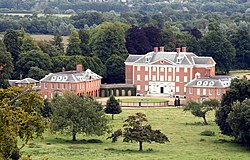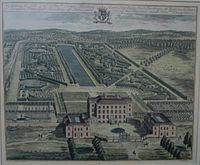Chevening House
| Chevening House | |
|
Kent | |
|---|---|
 Chevening | |
| Type: | Country house |
| Location | |
| Village: | Chevening |
| History | |
| Built 1617 - 1630 | |
| Country house | |
| Early Palladian | |
| Information | |
| Owned by: | Trustees of the Chevening Estate |
Chevening House is a large country house in the parish of Chevening in the west of Kent, just outside Sevenoaks and close to the border of Surrey. It was long a lordly seat, the principal seat of the Earls Stanhope: it is now a government official residence provided usually to the Foreign and Commonwealth Secretary.
It is set at the foot of the North Downs in extensive parkland. A garden to the south encircles a man-made lake.
The house is a Grade I listed building.[1] The surrounding gardens, pleasure grounds and park are listed Grade II* on the Register of Parks and Gardens.[2]
The house and estate are owned and maintained at the expense of the Trustees of the Chevening Estate, under the Chevening Estate Act 1959.[3]
History
There has been a house on the site since at least 1199 and the estate originally formed part of the archiepiscopal manor of Otford.
The present 15-bedroomed house was built between 1617 and 1630, possibly to the design of Inigo Jones.
The house was greatly extended from 1717 by the addition of symmetrical wings by Thomas Fort, a master carpenter and royal clerk of works who had worked under Christopher Wren at Hampton Court. Much remodelled by the 3rd Earl Stanhope in the late 18th century, the house was extensively restored in the 1970s by Donald Insall Associates for the Trustees of the Chevening Estate.
The house was for 250 years the principal seat of the Earls Stanhope, a cadet (and ultimately the final) branch of the Earls of Chesterfield, from 1717 to 1967. James Stanhope, 1st Earl Stanhope, was a general under Marlborough and a Whig politician who served as chief minister to King George I until his death in 1721. Through marriage he was the uncle of William Pitt the Elder. Philip Stanhope, 2nd Earl Stanhope, was tutored by Philip Stanhope, 4th Earl of Chesterfield and became a distinguished patron of science during the Enlightenment. Charles Stanhope, 3rd Earl Stanhope, both first cousin and brother-in-law to William Pitt the Younger, was a prolific inventor whose major achievements in such diverse fields as printing, building a mechanical calculator, steam navigation, optics, musical notation and fire-proofing in buildings were overshadowed at the time and subsequently by his reputation, as the self-styled "Citizen Stanhope", for eccentricity and political radicalism.
Philip Henry Stanhope, 4th Earl Stanhope, was a gifted amateur landscape gardener and architect, half-brother to Lady Hester Stanhope, and the legal guardian of Kaspar Hauser. Philip Stanhope, 5th Earl Stanhope, was the driving force behind the foundation of the National Portrait Gallery and the Historical Documents Commission: writing as Viscount Mahon he was a distinguished 19th-century historian and established the Stanhope Essay Prize at Oxford. Arthur Stanhope, 6th Earl Stanhope, was a Conservative Member of Parliament before inheriting and served as First Ecclesiastical Estates Commissioner from 1878 to 1903. Both his brothers made their careers in politics. The Rt Hon Edward Stanhope (Conservative) was a reforming Secretary of State for War (1887–1892), while the 1st Lord Weardale (Liberal) was president of the Inter-Parliamentary Union (1912–22) and of the Save the Children Fund.
James Stanhope, 7th Earl Stanhope (also 13th Earl of Chesterfield), was a Conservative politician who held office almost continuously from 1924 to 1940, serving in Cabinet posts from 1936 under Stanley Baldwin and Neville Chamberlain. He founded the National Maritime Museum at Greenwich.
Having no children of his own and his only brother having been killed in the Great War, the last Earl Stanhope wished to create at Chevening a lasting monument to a family that had provided for two and a half centuries politicians across the political spectrum and no fewer than five fellows of the Royal Society. He therefore drafted what became the Chevening Estate Act 1959 to ensure that the estate would not be broken up after his death, but would instead retain a significant role as a private house in public life. The ownership of the property would pass to a Board of Trustees, who would maintain it as a furnished country residence for a suitably qualified nominated person chosen by the Prime Minister. The nominated person would have the right to occupy the house in a private capacity and would pay for their private living expenses. The Board of Trustees would maintain the house and estate by means of their stewardship of the estate, with no grant from the Government. The Act was passed with cross-party support and (as amended by the Chevening Estate Act 1987) governs the estate to this day.
The first beneficiary of the Act was the 7th Earl himself, until his death in 1967. Thereafter the Board of Trustees launched a major programme of restoration of the house, gardens and parklands funded partly by his endowment and partly through their own management of the estate.[4]
In 1974 Charles, Prince of Wales, accepted the prospect of living on the estate. This did not proceed, although the Prince did visit the house several times. In 1980, His Royal Highness purchased Highgrove in Gloucestershire.
The house and its occupants
It is a 15-bedroomed house on three storeys, a symmetrical red brick structure in the early English Palladian style, attributed to Inigo Jones.
The house was extended from 1717 by the addition of symmetrical wings by Thomas Fort, a master carpenter and royal clerk of works who had worked under Christopher Wren at Hampton Court. Much remodelled by the 3rd Earl Stanhope in the late 18th century, the house was extensively restored in the 1970s by Donald Insall Associates for the Board of Trustees of the Chevening Estate.
The purpose of the house according to the trust is to serve as a furnished country residence for a person nominated by the Prime Minister, so qualified by being a member of the Cabinet or a descendant of King George VI. The nominee pays for their own private living expenses when in residence but government departments arrange and effect official business at the estate. The Canadian High Commissioner, the American Ambassador and the National Trust all have remainder interests in Chevening in the unlikely event that none of the others requires the house.
The usual nominee is the Secretary of state for Foreign and Commonwealth Affairs. It has on occasion been allocated to the Deputy Prime Minister when that post has existed (and in 2021 was allocated jointly to the Foreign Secretary and the Deputy Prime Minister). Under special arrangements with the Board of Trustees, the house is also available to the Secretary of State for International Trade and was made available to the Secretary of State for Exiting the European Union, while that post existed. When circumstances permit, the house may be used for meetings or conferences, usually by other Government departments, through arrangement with the Trustees.
Literary connections

It has sometimes been suggested that Chevening served Jane Austen as a model for Rosings Park in her novel Pride and Prejudice, but the only established fact that links the novelist with Chevening is that the Revd John Austen, her second cousin and grandson of the solicitor Francis Austen, who lived in the Red House, Sevenoaks, became Rector of Chevening in 1813, the novel having been published in that January.[5] However, it was written from October 1796 to August 1797. John Halperin also relates that Francis Austen, an uncle of Jane Austen's father, was solicitor to the owners of Chevening during the latter third of the 18th century; that Francis Austen owned property in the area, and that Jane Austen visited him and relatives in Kent several times between 1792 and 1796.
The poet Robert Selby was a longstanding resident of the Chevening area. His poetry collection The Coming-Down Time (Shoestring Press, 2020)[6] includes a sequence entitled 'Chevening', partially set in the grounds of Chevening House and in St Botolph's church opposite.
Chevening scholarship programme
Chevening is the name of the government's international awards scheme, the Chevening Scholarships, founded in 1983 to develop global leaders. While the programme takes its name from the house, the Chevening Secretariat administers the awards on behalf of the Foreign and Commonwealth Office. The Secretariat is based at Woburn House in London and is part of the Association of Commonwealth Universities.
See also
- Chequers, the British Prime Minister's official country retreat, near Wendover in Buckinghamshire.
- Dorneywood, a country retreat in Burnham, Buckinghamshire, periodically assigned to a senior British government minister.
Outside links
| ("Wikimedia Commons" has material about Chevening House) |
References
- ↑ National Heritage List 1085853: Chevening House (Grade I listing)
- ↑ National Heritage List : 1000258Chevening House (Register of Historic Parks and Gardens)
- ↑ Chevening Estate Act 1959 (1959 Chapter 49 7 and 8 Eliz 2)
- ↑ Wilson, Michael (2011). A House of Distinction.
- ↑ Halperin, John (1989), "Inside Pride and Prejudice", Persuasions (Jane Austen Society of North America) (11), http://www.jasna.org/persuasions/printed/number11/halperin.htm, retrieved 9 December 2018
- ↑ https://thescores.org.uk/neilson-on-selby/
- Wilson, Michael. A House of Distinction.
- Sedgemore, Brian (1995). The Insider's Guide to Parliament. Cambridge: Icon Books. ISBN 1-874166-32-3.
